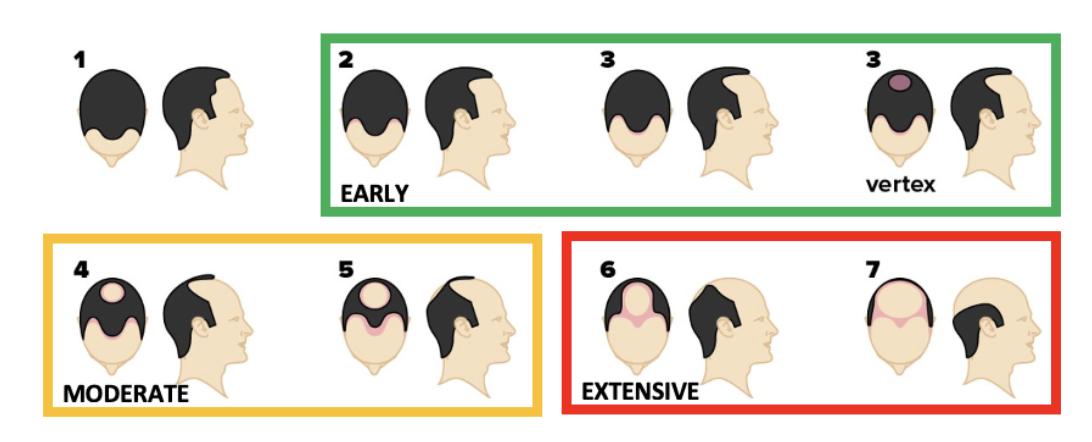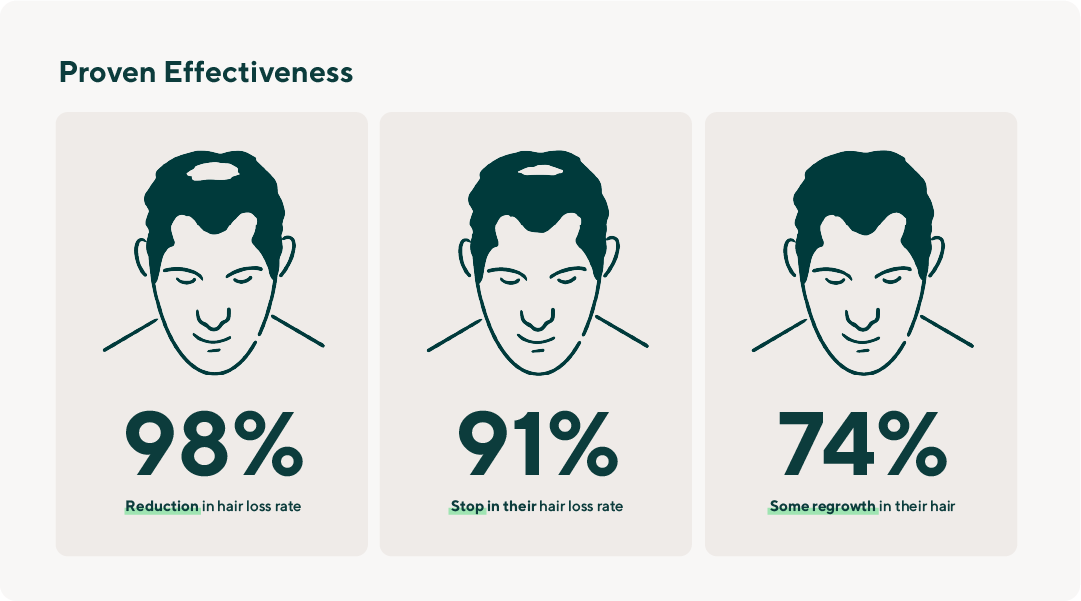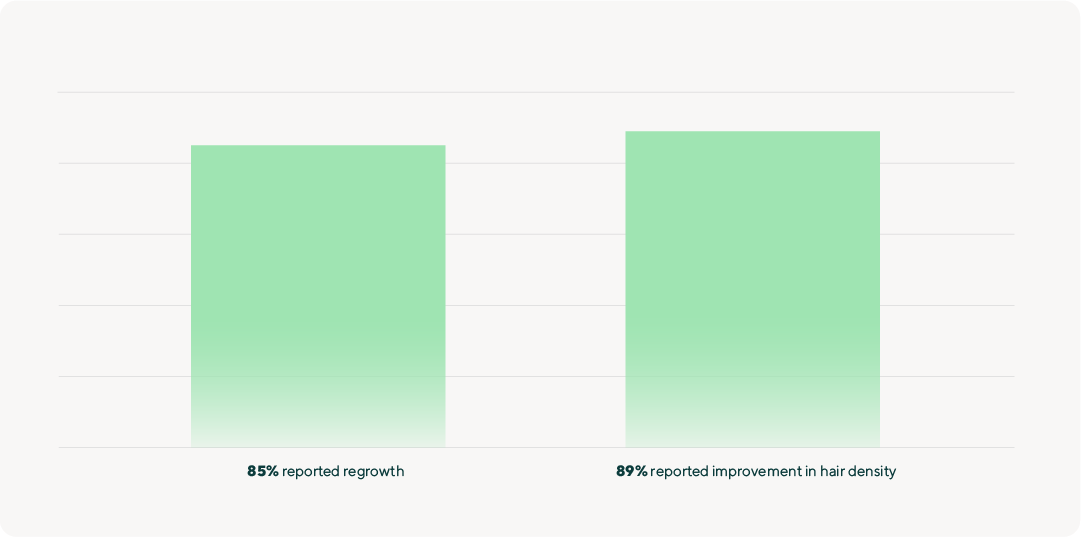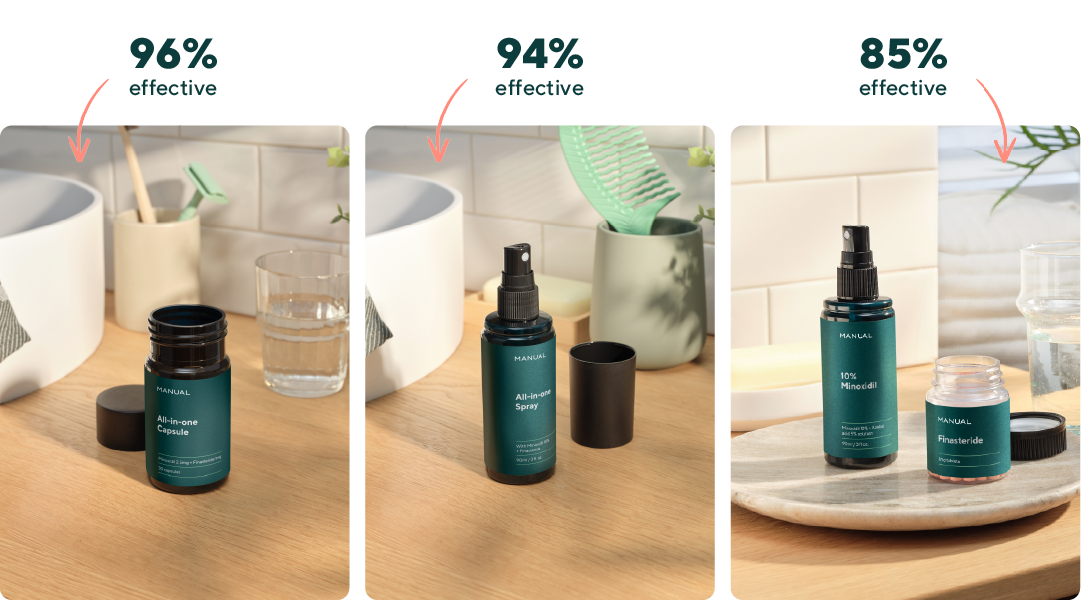Objective
To evaluate the effectiveness of MANUAL’s treatment service on the treatment of androgenetic alopecia (AGA), also known as ‘male pattern hair baldness.
Introduction
What is androgenetic alopecia and what causes it?
Navigating hair loss can be a difficult, emotional and confusing journey, particularly when facing androgenetic alopecia (AGA) – more commonly known as ‘male pattern baldness’. AGA is the leading cause of hair loss, affecting 50% of men aged 50+ and 50% of women aged 65+ in the UK1, and follows a well-defined pattern that can be characterised using the Norwood scale (7 stages).

AGA is a complex condition triggered by an excessive response to androgens, notably Dihydrotestosterone (DHT), that results in gradual miniaturisation of hair follicles and eventually leads to hair thinning and eventual hair loss. It is caused by a combination of genetic, hormonal, and environmental factors. However, its exact link to some of these factors is unknown, making it often challenging to treat2. This complexity adds an extra challenge when it comes to developing effective treatment strategies. However, there are options.
Learn more about the early signs of balding here, and the stages of male pattern baldness here.
Get additional information on how stress, anxiety, smoking, and hormonal imbalances may cause hair loss.
Experiencing sudden hair loss, and not sure why? Read more here.
What does the research say about AGA?
Studies have shown that symptoms of AGA can lead to emotional distress, depression, low self-esteem, anxiety, and a decrease in socialising. This dip in mental health and overall well-being shows a real need for effective treatment options to address not just the physical aspects of hair loss, but also the broader impact on a person’s life.3 4 5 6.
If you are looking for strategies on how to make your hair appear thicker, click here.
Struggling with dandruff? Take a look here.
What can I do? Are there potential solutions?
By recognising the challenges faced by individuals dealing male pattern hair loss (AGA), MANUAL–one of the largest providers of prescription-only hair loss treatments in the UK–offers a hair loss service to men who have a Norwood Scale rating of 2-6, with treatments containing active ingredients such as minoxidil and/or finasteride.
These medications are specifically formulated to not only slow down the progression of hair loss but also to stimulate regrowth, presenting the potential for individuals to regain control over their hair, and by extension, improve their confidence and self-esteem. To test the effectiveness of MANUAL’s hair loss treatment service, we conducted a cross-sectional survey of eligible patients currently on treatment.
Learn more about the difference between minoxidil and finasteride treatments here, and what happens if you use a combination of both medications here.What are the side effects of minoxidil and finasteride? A complete guide of what you need to know.
Survey Methods
We conducted an online survey during June 2023 of patients of MANUAL between the ages of 35-65. Survey participants were recruited through mailing lists and social media channels. Potentially eligible participants received an invitation email from the study team.
Respondents were given information on the study’s aims and objectives. Respondents were assured that this was a voluntary survey and would not affect their treatment or care. The survey of 33 questions was accessible using a smartphone or computer.
Questions included demographic information and factors affecting their hair loss (sex at birth, age, ethnicity, educational level, salary, employment status, history of hair loss in the family), effectiveness of MANUAL’s hair loss treatment plans, and overall health goals.
Survey Results
The electronic survey captured data from 187 respondents between 01/06/23 and 30/06/23. Responses were excluded for the following reasons: incomplete questionnaires (N=65) and duplicate responses (N=17). 105 responses were included in the final study analysis. Respondents were categorised by age, severity of hair loss, and treatment type.
Demographic Data
Out of the total included responses, most respondents were white (77%), followed by Asian or Asian British (10%), Mixed or multiple ethnicities (9%) and Black, Black British, Caribbean or African (4%). Annual household income was as follows: £45k-75k (27%), <£20k (20%), prefer not to say (20%), £30k-45k (16%), £75k-125k (10%), and >£125k (7%).
Medication Use
After patients consented to receive treatment, they were offered the following service plans:
- Minoxidil (spray or oral capsule)
- Finasteride (oral tablet)
- All-in-One Treatment (proprietary blend of Minoxidil+Finasteride; spray or oral capsule)
- The Complete Hair Loss Plan (Minoxidil spray + Finasteride tablet)
Of the total included respondents, 39% reported using the All-in-One Capsule, 33% used topical treatments, and 28% were on MANUAL’s Complete Hair Loss Plan. 77% reported concurrently using two or more hair loss treatments.
Respondents’ Hair Loss Background
The majority of respondents reported experiencing hair loss at the temples and crown (70%), followed by temples only (19%), then by complete or extensive hair loss (11%).

76% of respondents had reported experiencing hair loss for over 3 years before starting with MANUAL’s treatment service, with 41% having tried alternative hair loss solutions.
Stress was identified as the most common contributing factor (47%) to hair loss. Lack of sleep (33%) and poor diet (19%) were also notable contributors. Smoking (5.7%) and chemical exposure (5.7%) were less commonly mentioned, but highly impactful factors.
Proven Effectiveness
Overall, 98% of respondents reported a reduction in hair loss rate, 91% reported a stop in their hair loss, and 74% reported some regrowth. Notably, among the patients who had used MANUAL’s hair loss service for >12 months, 85% reported regrowth, and 89% reported improvement in hair density upon reviewing their progress photos.

On evaluation of oral vs. spray treatments, the All-in-One capsule was found to be the most effective (96%). The All-in-One spray plan was the second most effective at 94%, and the complete hair loss plan was 85% effective.

Boosting Confidence
90% of respondents reported increased confidence levels since starting treatment, citing the primary reason as improved hair health and growth. Respondents who had taken up MANUAL’s free consultation service with a hair loss specialist clinician reported higher confidence levels and better hair regrowth. Interviews following the survey demonstrated that the improvement in confidence levels led to greater performance at work and in their social lives.
TL:DR / Summary
92% of respondents reported that their hair loss slowed down, stopped, or started regrowing after 12 months of using MANUAL’s hair loss service. 73% experienced a reduction in hair loss rate by their 6th month on their plan; this was higher among people who used oral treatments.
Discussion
These results for the hair loss treatments are noteworthy. In particular, the highest success was observed in the male patients who used a synergistic approach of combining treatments on the service, continued with the treatment service for at least one year, or engaged with MANUAL hair loss clinical specialists (utilising MANUAL free consultation services).
When compared to participants who stopped treatment before the 12-month time point, those who were on treatment for over 12 months experienced a 43% greater level of hair loss before starting treatment. Interestingly, among patients who had a free consultation with a MANUAL hair loss specialist, results improved by 27%. While these results need further investigation, it is likely the two primary contributing factors were that: (1) patients could optimise and improve the application of their treatments on the service, (2) clinical advice allowed for improved knowledge and expectations of the treatment’s effects, including side effects, improving overall compliance with usage, and (3) patients were able to reach their goals more quickly while also sustaining results long term.
These findings show the importance of comprehensive, long-term therapeutic approaches that utilise a combination of treatments and support from healthcare professionals in managing AGA. While these findings are promising, further research on larger populations and with longer timeframes is needed to provide insights into the long-term sustainability of the observed benefits on hair density and quality of life.
We will be conducting further research in collaboration with top Universities in the UK. If you are interested in participating and gaining early access to findings, please sign up here. Your involvement could be a vital part of shaping the trajectory of obesity research. We value your potential contribution to fostering positive developments in overall well-being.
While we've ensured that everything you read on the Health Centre is medically reviewed and approved, information presented here is not intended to be a substitute for professional medical advice, diagnosis, or treatment. It should never be relied upon for specific medical advice. If you have any questions or concerns, please talk to your doctor.


